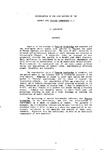OPTIMISATION IN THE LIFE HISTORY OF THE HERMIT CRAB PAGURUS BERNHARDUS ( L.)
| dc.contributor.author | LANCASTER, IAN | |
| dc.contributor.other | School of Biological and Marine Sciences | en_US |
| dc.date.accessioned | 2013-10-28T10:29:04Z | |
| dc.date.available | 2013-10-28T10:29:04Z | |
| dc.date.issued | 1988 | |
| dc.identifier | NOT AVAILABLE | en_US |
| dc.identifier.uri | http://hdl.handle.net/10026.1/2399 | |
| dc.description.abstract |
Aspects of the ecology of Pagurus bernhardus are examined and the strategies which enable this species to exploit two quite different habitats are determined. The area of shell selection is reviewed and mathematical indices of shell adequacy are rejected as biologically flawed. A subjective index is proposed to more accurately describe the quality of a hermit crab shell resource. Shell preference is considered to be an artificial phenomenon and shell selection is demonstrated to be an essentially random process. Shell-limitation is considered one of the most common problems facing all populations of hermit crabs, detrimentally affecting growth, fecundity, and longevity. The reproductive cycle of Pagurus bernhardus is examined, and the period spent in the littoral zone is considered critical in the life history. Breeding is shown to occur only during the winter months in littoral populations, and is shown to require two interacting stimuli. Low temperatures affect egg production in the female; while reduced photoperiods affect breeding behaviour in the male. Gestation is shown to require some 43 days at temperatures of 8-10°c, and most females will produce two broods during a breeding season. Females are sexually mature in their first year and precocious breeding is seen as a vital strategy to overcome the restrictions of shell-limitation. The monitoring of marked individuals indicates that Pagurus bernhardus is not territorial, and that the distribution of individuals on a shore is essentially random. The patterns of movement, the non-breeding interactions between individuals, and the residence times of these animals on a shore are suggested to be most strongly influenced by the quantity and quality of their shell contacts. Migration into the sublittoral is seen as an inevitable consequence of this behaviour. | en_US |
| dc.language.iso | en | en_US |
| dc.publisher | University of Plymouth | en_US |
| dc.title | OPTIMISATION IN THE LIFE HISTORY OF THE HERMIT CRAB PAGURUS BERNHARDUS ( L.) | en_US |
| dc.type | Thesis | |
| dc.identifier.doi | http://dx.doi.org/10.24382/3694 | |
| dc.identifier.doi | http://dx.doi.org/10.24382/3694 |
Files in this item
This item appears in the following Collection(s)
-
01 Research Theses Main Collection
Research Theses Main


